U.S. Department of Transportation
Federal Highway Administration
1200 New Jersey Avenue, SE
Washington, DC 20590
202-366-4000
Federal Highway Administration Research and Technology
Coordinating, Developing, and Delivering Highway Transportation Innovations
| REPORT |
| This report is an archived publication and may contain dated technical, contact, and link information |
|
| Publication Number: FHWA-HRT-16-061 Date: November 2016 |
Publication Number: FHWA-HRT-16-061 Date: November 2016 |
The current study was conducted to provide empirical support for recommending standard wording of ICWS signs and provide guidance on the placement of warnings on the minor road approaches. The study consisted of four parts.
In the first part, each participant viewed six animations of approaches to intersections with ICWSs. After each video, they were shown still images of the ICWS sign in the video and asked the following two questions: (1) “Please tell us what you would do in response to the sign(s) with the flashing yellow lights” and (2) “What does the warning sign mean?”
In the second part, participants were told the purpose of a particular ICWS sign and then asked to agree or disagree with statements about that sign. Each statement was rated on a seven-point scale where a rating of 1 represented “strongly agree” and a rating of 7 represented “strongly disagree.”
In the third part, participants were asked to rank alternative messages that might be displayed on the sign from the best to the least desirable. There were 9 alternative wordings for the minor approach and 10 alternative wordings for the major road approach. Each set of rankings was done twice, once with the “WHEN FLASHING” placard present and once without. After each of the four ranking exercises, participants were asked to explain what factors influenced their rankings.
In the fourth part, participants were shown images of signs or pairs of signs and asked to agree or disagree with statements concerning the meaning of the flashing beacons or the various states of the blank-out signs.
In all four parts, the stimuli were presented on a 60-inch color liquid crystal display (LCD) screen with a resolution of 1,920 horizontal by 1,080 vertical pixels. Participants were seated about 8 ft from the screen. A table with a large mouse pad and mouse were positioned in front of the participants’ chairs. Participants used a mouse to make rating and ranking responses. A research assistant transcribed verbal responses. The transcriptions were displayed on the LCD screen, and participants were asked to verify transcription accuracy. The room was dimly lit to minimize reflections on the LCD screen.
All of the signs used in this study were developed with SignCAD® software.(9) This software ensured that all the signs were compliant with the Manual on Uniform Traffic Control Devices (MUTCD) except where noted.(1) In scaling signs to the specified dimensions for a given viewing distance, the animation software used for this study can result in legibility distances that are less than would typically be experienced in the real world. To overcome this limitation, all diamond signs used in the videos were scaled to 60 inches per side. In addition, for most of the signs, FHWA E modified font was used instead of the FHWA C font that would normally be used on diamond-shaped warning signs.(10) Otherwise, the spacing of letters and words complied with the MUTCD.(1)
Upon arrival at the laboratory, participants reviewed and signed a record of informed consent, presented their valid driver’s licenses, and completed a vision test using a Bailey Lovie eye chart. After these preliminaries, they were seated in front of the LCD screen and completed the four parts of the experiment. The four parts were always administered in the same order as enumerated in the following sections.
PART 1: WHAT WOULD YOU DO AND WHAT DOES THE SIGN MEAN?
Three of the six videos featured ICWS signs on the through road approach to a stop-controlled intersection, and the remaining three featured ICWS signs for the stop-controlled approach. For each of the three through and stop-controlled approaches, one had a two-lane through road, one had a four-lane undivided through road, and one had a four-lane divided through road. Given that there were 18 different word messages to be evaluated, two different sign locations on the minor road, and warnings with and without a “WHEN FLASHING” placard, only a limited number of options could be displayed in 6 videos. To partially address this limitation, there were 12 videos, with the same 6 scenarios (3 minor road approaches and 3 major road approaches) with different combinations of wordings, placards, and static versus blank-out signs on the 2 sets of 6 videos. To further mitigate the limitation of only 12 unique videos, 6 different orders of video scenarios were used.
All of the videos were created with Autodesk InfraWorks® 360. This software enables users to download roadway alignments, elevation data, and other infrastructure information for many geographic locations. From this information, visualizations of various roadway design proposals can be created. For this study, data for the following three intersections were downloaded:
The Buffalo Shoals/Shuford and U.S. 151/Old Dubuque intersections were selected because they had existing ICWS treatments. Videos were created for each of the four approach legs of the three intersections, and different ICWS sign/placard treatments were modeled on each approach.
The content of the six video animations shown to each of six groups of participants is described in table 7.
Table 7. Video animation content.
| Approach Road | Approach Direction | Major Road | Message | Placard | Road Class | Blank- Out | Sign Location |
|---|---|---|---|---|---|---|---|
Group 1 |
|||||||
Richland |
North |
4 L U |
Entering vehicles |
No |
Major |
No |
Right |
Ervintown |
North |
4 L U |
Approaching traffic |
Yes |
Minor |
Yes |
Across |
Old Dubuque |
East |
4 L D |
Watch for approaching traffic |
No |
Minor |
No |
Missouri |
Shuford |
South |
2 L |
Cross traffic |
No |
Minor |
Yes |
Across |
U.S. 151 |
North |
4 L D |
Watch for entering vehicles |
Yes |
Major |
No |
Right|Left |
Buffalo Shoals |
South |
2 L |
Crossing vehicle |
Yes |
Major |
No |
Right |
Group 2 |
|||||||
Richland |
East |
4 L U |
Expect entering traffic |
No |
Major |
No |
Right |
Buffalo Shoals |
North |
2 L |
Crossing vehicle |
Yes |
Major |
No |
Right |
US 151 |
South |
4 L D |
Traffic entering |
No |
Major |
No |
Right|Left |
Shufford |
North |
2 L |
Approaching vehicle |
Yes |
Minor |
No |
Across |
Old Dubuque |
West |
4 L D |
Traffic approaching when flashing |
Yes |
Minor |
No |
Missouri |
Ervintown |
South |
4 L U |
Expect cross traffic |
No |
Minor |
Yes |
Missouri |
Group 3 |
|||||||
Buffalo Shoals |
North |
2 L |
Crossing vehicle |
Yes |
Major |
No |
Right |
Richland |
North |
4 L U |
Entering vehicle |
No |
Major |
No |
Right |
U.S. 151 |
South |
4 L D |
Traffic entering |
No |
Major |
No |
Right|Left |
Shuford |
South |
2 L |
Cross traffic |
No |
Minor |
Yes |
Across |
Old Dubuque |
West |
4 L D |
Traffic approaching when flashing |
Yes |
Minor |
No |
Missouri |
Ervintown |
North |
4 L U |
Approaching traffic |
Yes |
Minor |
Yes |
Across |
Group 4 |
|||||||
Shuford |
North |
2 L |
Approaching vehicle |
Yes |
Minor |
No |
Across |
Old Dubuque |
East |
4 L D |
Watch for approaching traffic |
No |
Minor |
No |
Missouri |
Ervintown |
South |
4 L U |
Expect cross traffic |
No |
Minor |
Yes |
Missouri |
U.S. 151 |
North |
4 L D |
Watch for entering vehicles |
Yes |
Major |
No |
Right|Left |
Buffalo Shoals |
South |
2 L |
Crossing vehicle |
Yes |
Major |
No |
Right |
Richland |
East |
4 L U |
Expect entering traffic |
No |
Major |
No |
Right |
Group 5 |
|||||||
Old Dubuque |
West |
4 L D |
Traffic approaching when flashing |
Yes |
Minor |
No |
Missouri |
Shuford |
South |
2 L |
Cross traffic |
No |
Minor |
Yes |
Across |
Richland |
East |
4 L U |
Expect entering traffic |
No |
Major |
No |
Right |
U.S. 151 |
South |
4 L D |
Traffic entering |
No |
Major |
No |
Right|Left |
Ervintown |
North |
4 L U |
Approaching traffic |
Yes |
Minor |
Yes |
Across |
Buffalo Shoals |
North |
2 L |
Crossing vehicle |
Yes |
Major |
No |
Right |
Group 6 |
|||||||
Old Dubuque |
East |
4 L D |
Watch for approaching traffic |
No |
Minor |
No |
Missouri |
Shuford |
North |
2 L |
Approaching vehicle |
Yes |
Minor |
No |
Across |
Ervintown |
South |
4 L U |
Expect cross traffic |
No |
Minor |
Yes |
Missouri |
Buffalo Shoals |
South |
2 L |
Crossing vehicle |
Yes |
Major |
No |
Right |
Richland |
North |
4 L U |
Entering vehicle |
No |
Major |
No |
Right |
U.S. 151 |
North |
4 L D |
Watch for entering vehicles |
Yes |
Major |
No |
Right|Left |
2 L = Two-lane.
4 L D = Four-lane divided.
4 L U = Four-lane undivided.
A screenshot from one of the two approaches on a two-lane through road to a two-lane stop- controlled intersection is shown in figure 3. A screenshot of one of two approaches on a four-lane divided highway to a two-lane stop-controlled intersection is shown in figure 4. One of two approaches on a four-lane undivided highway to a two-lane stop-controlled intersection is shown in figure 5. One of two stop-controlled intersections with a two-lane through road is shown in figure 6. One of two stop-controlled intersections with a four-lane undivided highway is shown in figure 7. One of two stop-controlled intersections with a four-lane divided highway is shown in figure 8.
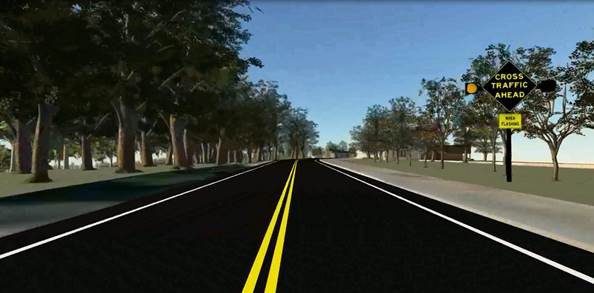
Figure 3. Screenshot. Blank-out sign with “WHEN FLASHING” placard along two-lane approach to a stop-controlled cross street.
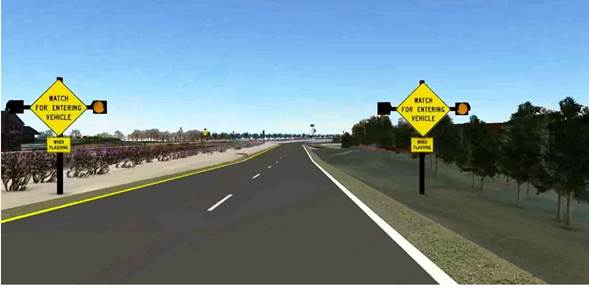
Figure 4. Screenshot. ICWS signs on four-lane divided highway approach.

Figure 5. Screenshot. ICWS sign on four-lane undivided highway approach.
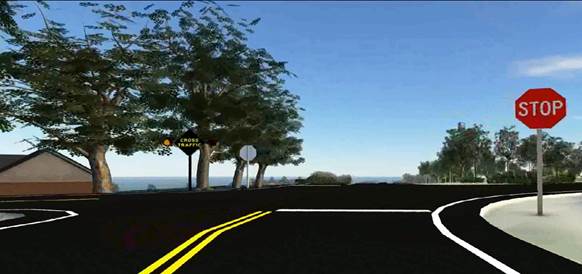
Figure 6. Screenshot. ICWS warning at intersection with two-lane highway.
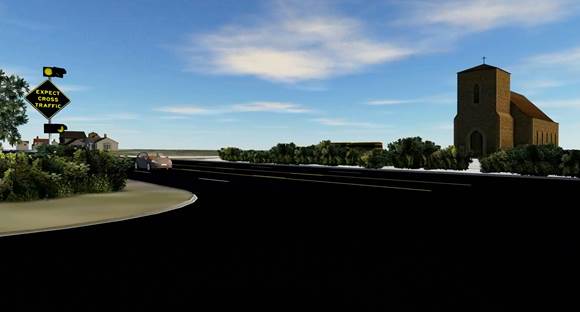
Figure 7. Screenshot. ICWS warning at stop-controlled intersection with four-lane undivided highway.
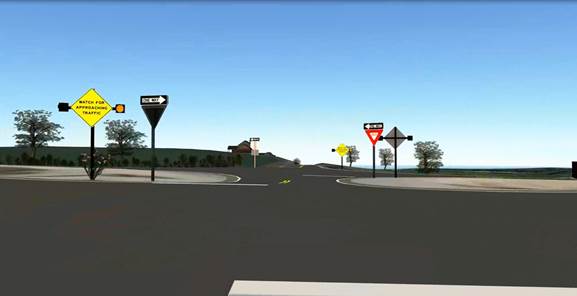
Figure 8. Screenshot. ICWS at stop-controlled approach to four-lane divided highway.
PART 2: ICWS SIGN PERCEPTIONS
In an effort to assess perceptions and attitudes regarding ICWS, participants were presented with 21 statements concerning an ICWS sign and asked to agree or disagree with the statement using a 7-point scale. Before providing these ratings, the participant was given a brief explanation of the sign used in connection with each of the statements. There were two explanations. The minor road explanation is shown in figure 9, and the explanation for the major road warning signs was “This sign is used on a major road to alert drivers that a vehicle has been detected that is about to enter the highway from a cross street.” For any particular participant, the same warning sign message was shown next to each of the 21 statements. Different messages were each of six participant groups. The minor road messages were as follows:
The major road messages were as follows:
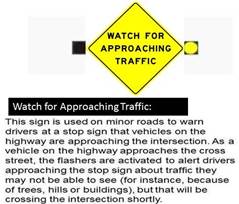
Figure 9. Screenshot. Explanation of ICWS sign on minor road approach.
None of the signs shown in this part were accompanied by a “WHEN FLASHING” placard. There were 6 different orders for the 21 statements that were evenly distributed across participants.
Figure 10 shows an example of how the statements were presented. Participants made their ratings by using a mouse to click on one of the seven numbers on the left half of the screen. The statements were as follows:
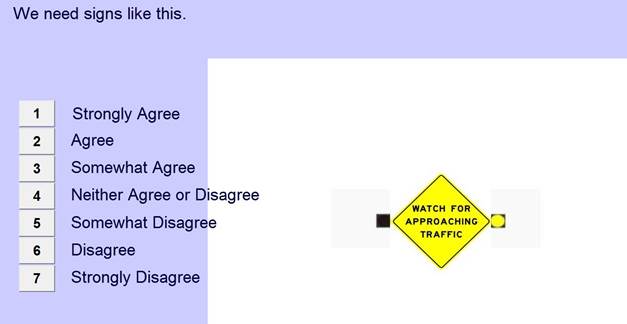
Figure 10. Screenshot. Example of screen used for obtaining agreement ratings.
The statements were organized around a few themes so that a factor analysis of the ratings could potentially reveal something about the mental model participants had of the ICWS. These themes were as follows:
A balance was sought between questions concerning how the participant would react (e.g., I would trust this warning) and how the participant thought other drivers would react (e.g., other drivers will ignore this sign). A balance was also sought in questions with a positive valance (e.g., we need signs like this) and a negative valance (e.g., signs like this are distracting).
PART 3: PREFERENCE RANKING
In this portion of the experiment, participants were asked to rank the alternative wordings on ICWS signs from most preferred to least preferred. There were 9 alternative wordings for the minor road approaches and 10 alternative wordings for the major road approaches. The ranking was preceded by one of the signs and an explanation of the purpose of the sign (the same explanations as provided in part 2). The rankings were performed four times for each approach (major and minor) and with and without the “WHEN FLASHING” placard. Alternatives that included “when flashing” on the diamond sign were always displayed without the placard.
Figure 11 provides an example of the display used to elicit the rankings. A letter was displayed beneath images of signs with each wording. Above the images, on the left side of the screen, were tiles that each had a letter of the alphabet. Participants were asked to use a mouse to drag the tiles from the left side of the screen to the right side and order the letters from top to bottom according to their preference. The initial order of letter tiles was randomized for each participant. Six different orders of the signs, evenly distributed across participants, were displayed across the bottom of the screen.
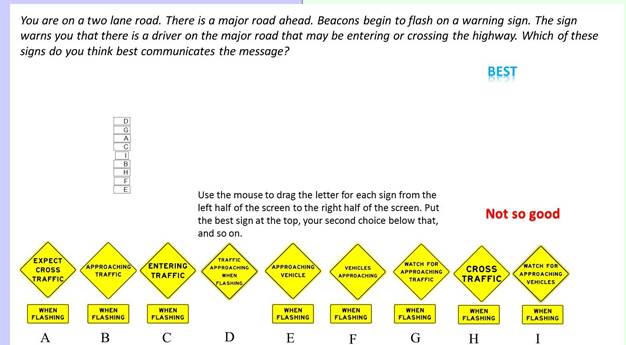
Figure 11. Screenshot. Example of rating screen for nine alternative minor road warnings.
The wording choices for minor roads were as follows:
The wording choices for major roads were:
Immediately after each ranking exercise, participants were asked to explain why they ranked the signs the way they did. Their verbal responses were transcribed by the researcher. An example of the screen displayed while participants explained their preferences is shown in figure 12.

Figure 12. Screenshot. Example of screen shown while participants were asked to explain their preferences.
PART 4: COMPREHENSION
Some agencies use the “WHEN FLASHING” (W16-13) placard with ICWS signs while others do not.(1) The placard is intended to indicate the immediacy of the warning when the beacons are flashing. However, some agencies are concerned that motorists might interpret the signs to mean that no hazard is present when the beacons are not flashing. One goal of the questions in this section was to provide an estimate of how participants interpret the presence or absence of the “WHEN FLASHING” placard. The questions addressing this issue are shown in figure 13 through figure 15.
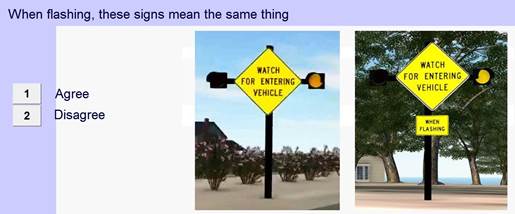
Figure 13. Screenshot. Screen examining comprehension of ICWS signs with placard when the beacons are flashing.
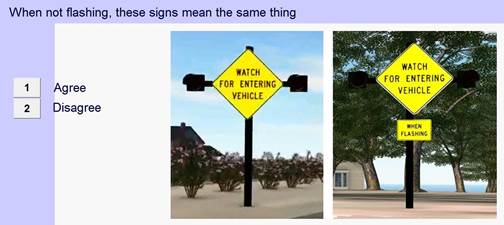
Figure 14. Screenshot. Screen examining comprehension of ICWS signs with placard when the beacons are not flashing.
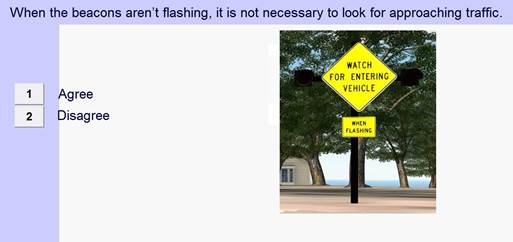
Figure 15. Screenshot. Screen examining whether driver would check for traffic when beacons are not flashing.
Some agencies use blank-out signs for ICWS signage. The main intent of using a blank-out sign is to display no message at all when the beacons cannot function, such as during a power outage. Another goal of this part of the study was to provide an estimate of how the participants interpret ICWS blank-out signs when they are blank. Figure 16 through figure 21 show the screens used to assess comprehension of blank-out ICWS signs.
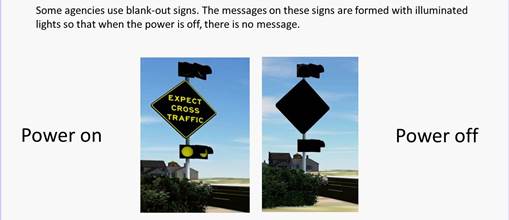
Figure 16. Screenshot. Screen used to explain why blank-out signs are used.
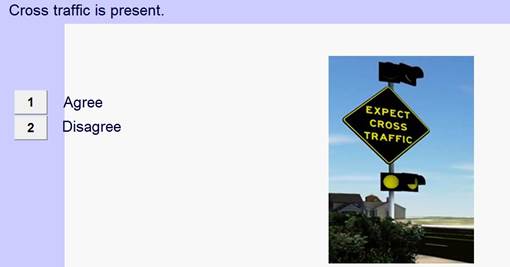
Figure 17. Screenshot. Screen used to assess comprehension of blank-out message when beacons are active.
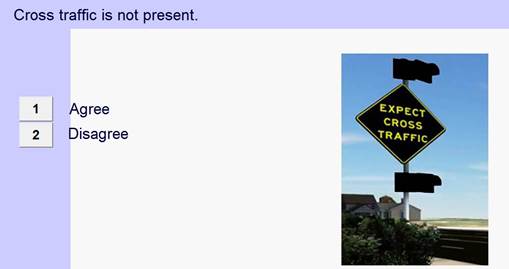
Figure 18. Screenshot. Screen used to assess blank-out sign understanding when the beacons are not active.
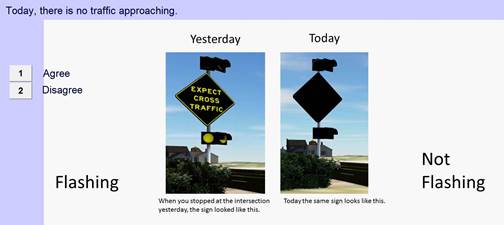
Figure 19. Screenshot. Screen used to asses blank-out sign understanding when the sign is blank.
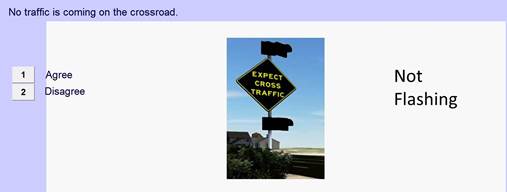
Figure 20. Screenshot. Screen used to assess interpretation of a blank-out sign when the sign is on but the beacons are not active.
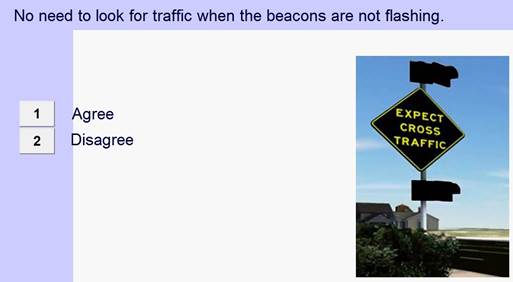
Figure 21. Screenshot. Second screen used to assess interpretation of a blank-out sign when the sign is on but the beacons are not active.
The final question in this section was intended to obtain a preference for the location of ICWS warning signs for minor road drivers at four-lane divided highways. This question asked whether the warning would be most effective if the signs were placed in a location close to where the approaching vehicles were located or directly across from the driver when looking forward at the stop sign. All of the participants had previously seen video animations that used both placement locations. Before asking which location they thought would be more effective, participants were shown short video clips with exemplars of each placement. Figure 22 shows the placement across from the stop line. Figure 23 shows the upstream placement. Figure 24 shows the screen that participants used to indicate their preference among the two setups.
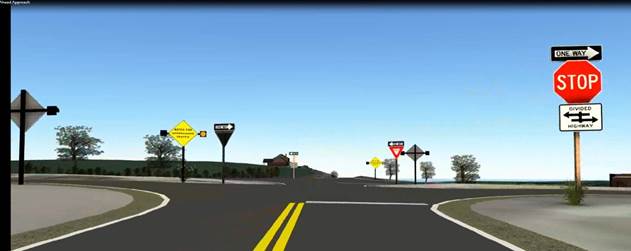
Figure 22. Screenshot. Exemplar from video showing the ICWS sign placement across from the stop and yield lines.
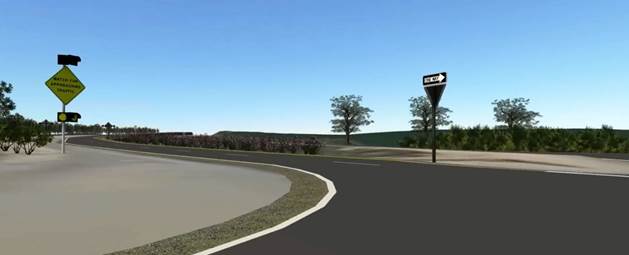
Figure 23. Screenshot. Exemplar from video showing the ICWS sign placements up stream on the cross road.
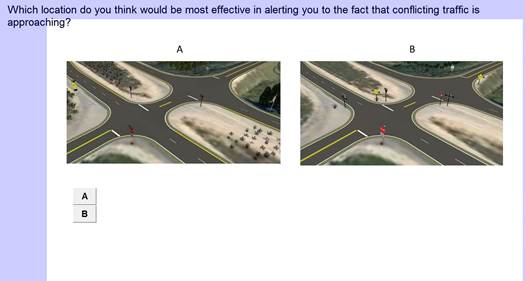
Figure 24. Screenshot. Screen from which participants indicated which sign placement they thought would be most effective.
PARTICIPANTS
Out of 189 participants, 96 participants were over 46 years old. Among the older participants, 48 were male, and 48 were female. Among the younger participants, 47 were male, and 46 were female. All participants possessed a valid driver’s license and had a visual acuity of 20/40 or better. All participants resided in the Washington, DC, metropolitan area, mostly in Northern Virginia. The mean age of male participants was 47 years old (range 19 to 78 years old), and the mean age of female participants was 45 years old (range 18 to 79 years old). All participants completed an informed consent form prior to beginning. The choice of age 46 as the criterion for splitting young from old age groups was somewhat arbitrary but still based on the fact that the median age database from which participants were recruited was 46 years old.